No products in the cart.
Goat
Gulabi Goat: A-Z Information You Need To Know
Gulabi goats have recently become more popular in the US, not only because of their efficiency and easy adaptation but also of their unique appearance. If you are keen on starting to welcome a flock of Gulabi goats to your farm, this post is for you!
*This post may have affiliate links, which means I may receive commissions if you choose to purchase through links I provide (at no extra cost to you). As an Amazon Associate I earn from qualifying purchases. Please read my disclaimer for additional details.
What is a Gulabi goat?
Gulabi or Pateri goats are a common breed in the Middle East, especially in Pakistan and India. The word Gulabi in the Urdu language means “pink” and Pateri in Sindhi means “belted”.
This unique breed of goats is originally raised to supply milk as well as meat. They are white in color, some have topped black/brown heads and most noticeably, they have long, wide ears dropped to the side of their head.
Because of this adorable look as well as their friendly, attention-loving nature, Gulabi goats are also widely kept as pets in the U.S
Gulabi goat origin
There are in total 4 different breeds that are involved in the origin of Gulabi goat. They are Beetal, Rajhanpuri, Pateri, and Kamori, which are all dual-purpose goats, meaning they are kept for both meat and milk.
The Beetal and Rajhanpuri have the most influence in the creation of the Gulabi breed, following are Pateri and Kamori.
Gulabi goat breed
Following is information about the 4 breeds that make up the Gulabi goat.
1. Beetal Goat
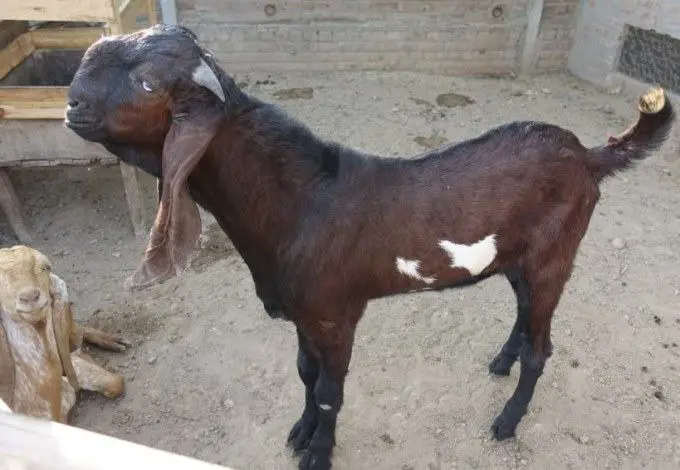
Beetal goats are very common in Pakistan. They have big and heavy bodies that are thicker close to the heads and they also have long legs. The male goat can weigh up to 55kg while the female one is around 45kg.
Beetal goats, thanks to their big and strong body, have an impressive capacity to produce milk. They can give from 1.8 to 2.7 liters of milk every day. That’s why this breed is commonly kept all year round.
The long, drooping ears characteristic of Gulabi goats has definitely come from its Beetal relatives. In terms of appearance, Beetal goats also have long, wide, drooping ears and they are usually multicolored.
Read more: How Do Goats Show Affection With Other Goats?
2. Rajanpuri Goat
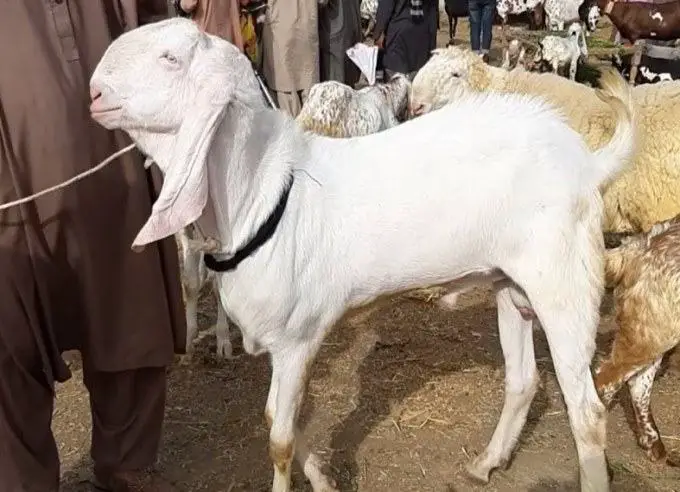
Like Beetal goat, Rajanpuri has the most influence on Gulabi goat. They also have large bodies, usually in white color. Their skin is pretty loose and often forms wrinkles.
This type of goats don’t have horns and they also have white hooves. Regarding appearance, Gulabi goats look much similar to Rajanpuri than Beetal.
The Rajanpuri goats mainly live in India and Pakistan and are also dual-purpose. Apart from meat and milk, they are also raised for their skin, which is known to be of good quality.
3. Pateri Goat
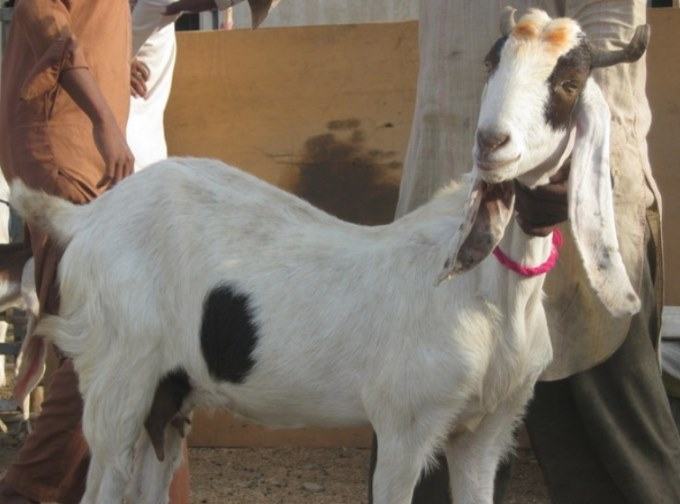
Pateri Goat doesn’t contribute to the Gulabi breed as much as the other previous two, but they still have a small influence. They are found in the province Sindh of Pakistan, where they are raised for both meat and milk.
Similar to Beetal and Rajhanpuri breed, Pateri goats are big, heavy-bodied goats that can produce more than 1 liter of milk per day. The adult goats weigh around 42kg to 52kg.
Pateri goats are commonly white in color with a reddish-brown face and neck. Like the other mentioned breed above, their ears are long and drop to the side, too. They do have horns but smaller than Beetal goats’.
4. Kamori Goat
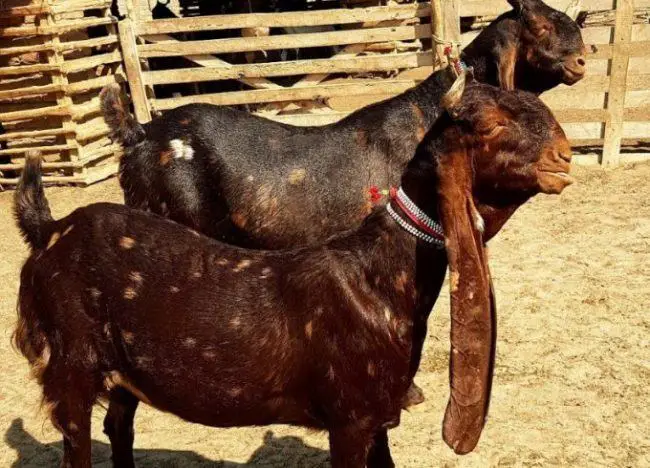
The last breed that does contribute to the origin of Gulabi goat is Kamori goat. They are also popular in the province of Sindh, Pakistan.
Although Kamori goats can produce good amounts of meat thanks to their large, heavy bodies, they are mainly kept for milk. Their milk-producing capacity ranges from 1.8 to 2.2 liters per day.
Kamori goat is also well-known and easily recognized by its distinctive appearance. Unlike the above breeds, they have dark brown fur with several small coffee-colored spots all over the body.
They don’t have horns and have drooping ears, too. These unique characteristics made them popular to be kept, especially for their beautiful color.
Uses of Gulabi goats
Primarily, Gulabi goats are raised for meat and milk. The goat milk industry is not as big and common as cow milk, in fact, the milk is mainly consumed by the family who keeps them. The maximum amount of milk per day can be up to 2 to 3 liters and is usually taken in 2 batches.
Since Gulabi goats are big in size, a characteristic inherited from their ancestors, they can be raised for meat as well. The weak one in the herd who is incapable of taking care of their calves will be killed. Usually, the festival is the time when Gulabi goat meat is mostly consumed.
Apart from being raised for meat and milk, Gulabi goats can be wonderful pets, too. They are amazingly friendly with kids and therefore are becoming more popular in a lot of house farms in the U.S. Their tame temperament also makes them suitable for entertaining shows.
Gulabi goat characteristics
Gulabi goats inherit many traits from their ancestors and are known to be of high efficiency in meat and milk production.
1. Gulabi goat size
Gulabi goat is tall and pretty large in size, which makes them suitable to be raised for meat
2. Gulabi goat weight
Gulabi goat adults’ weight varies from 45 kg up to 85kg. The male is heavier than the female, around 65 to 85kg.
A Gulabi goat baby is about 3kg when it is born and can gain 45-55g of body weight every day.
3. Gulabi goat ears
Gulabi’s droopy ears are definitely their most noticeable characteristic. Their ears are very wide and long enough that they can hang past their shoulders.
Too much skin creates wrinkles and ripples along with the ears and also under their chin. All of these traits are there for good reasons.
4. Reproductive ability
The male goats will reach their sexual maturity until they are around 9-12 months old. The first conception usually lasts 18 months, after that the kidding cycle happens once every 8 months.
It is very easy for Gulabi goats to have triplets and quadruplets.
4. Milk production
On average, a Gulabi doe can produce 2 to 3 liters of milk per day. Their milk is very tasty and contains around 3% fat, which makes it also healthy.
The does that have more calves generally have more milk than those with only one.
Gulabi goat price
Gulabi goat baby price varies from place to place but they are rather expensive.
In India and Pakistan, they cost around Rs 20000-35000. For an adult Gulabi goat, it can sometimes cost up to Rs 50000. In the US, the common price is 700$.
Frankly speaking, buying this breed can be very costly but considering their long-term worth in meat and milk production, it is a good investment.
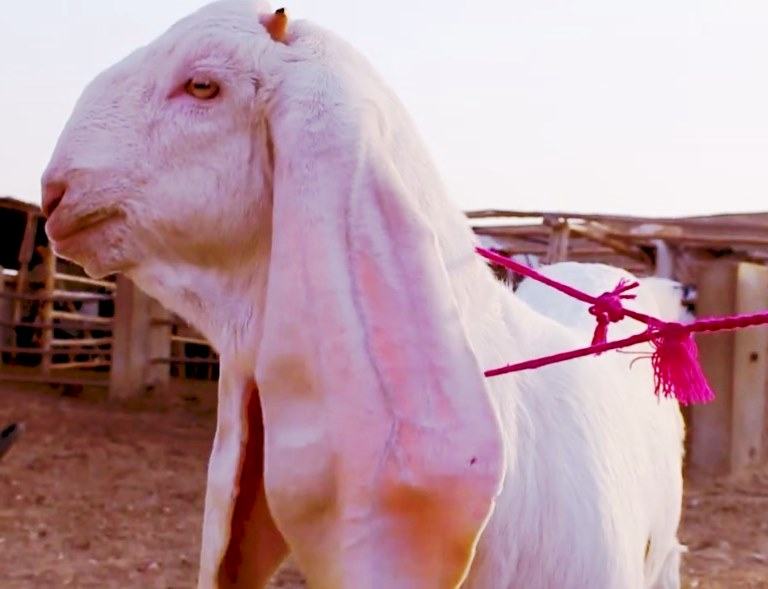
Gulabi goat breeder
How many bucks there should be in a herd is also a common question. The answer is 1 male in 20 females.
40-45 days is the ideal time for a buck to be kept with the does during the breeding season, which is enough for every doe to have at least 2 chances to be mated. Exceeding this time can result in them getting exhausted and ineffective mating.
However, if kidding planning isn’t necessary, the bucks can be kept with the does across the year. You shouldn’t expect them to have sudden conceptions, though.
Even staying with the females all year long, the males are only ready to mate during the breeding season.
Raising Gulabi goat
Gulabi goats are quite easy to raise thanks to their gentle temperament, which allows them to live in small farms, too.
You can keep them in a small shed but shouldn’t let the shed be wet or cold. A shed that is higher above the ground is a good idea.
They also like to have thick and clean bedding that should be placed separately from the feeding area. Remember to leave them with easy access to freshwater, too.
When there is one female who is expecting a baby, keep them separate from the herd and even the other females because they want to feel safe and secure. It is advised to build the kidding pen either near or inside the main shed.
In case there are new goats coming, always leave them in quarantine first to prevent diseases from spreading to the rest of the flock.
This step can also be taken ahead from the purchasing through checking with a local veterinarian.
How to choose a healthy Gulabi goat?
When choosing the male and female Gulabi goats to breed, you should pick from a reliable, good breeder. Since it will determine the long-term development of your flock, don’t simply buy a random goat in the market. You clearly don’t want to start with a couple of goats that produce unhealthy kids.
Some factors to take into consideration when choosing a healthy, potential breeding goat are short, strong horns, long neck, and muscled body.
Sufficient height is also a good sign of a healthy goat. For the doe, look for those who have well-formed udder with good teats.
Other Goat Breeds: Savanna Goats A-Z Information
Final words
A Gulabi goat is after all rather easy to keep. Being able to keep a well-developed and healthy flock of this goat is surely challenging and requires clear attention, but it will be rewarding in the end.
A Gulabi goat, not only is a productive type of goat on the farm, but also a friendly pet for your family. We hope this post is helpful to your Gulabi goat farming experience!
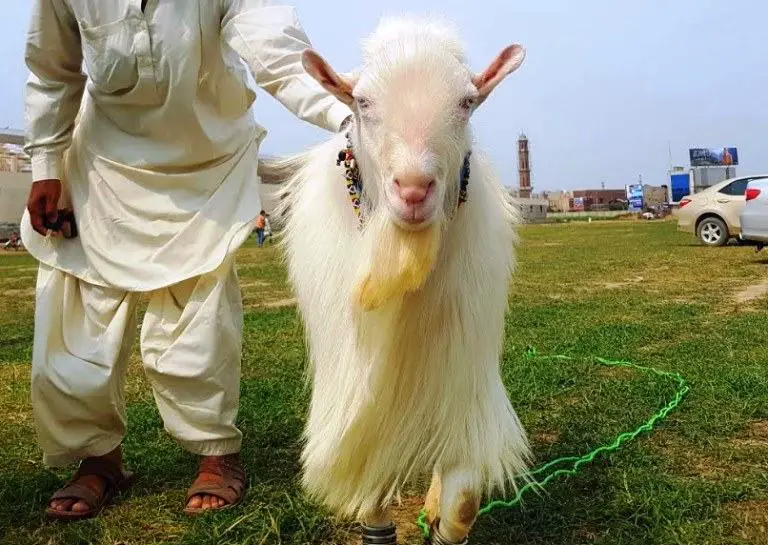

I am interested in goats phone 405-404-7069
sorry we do not sell goats, we just sharing knowledge about this breed.